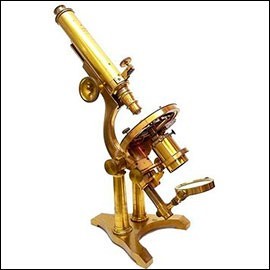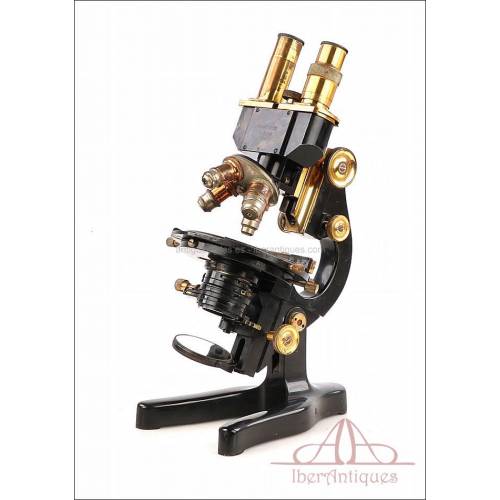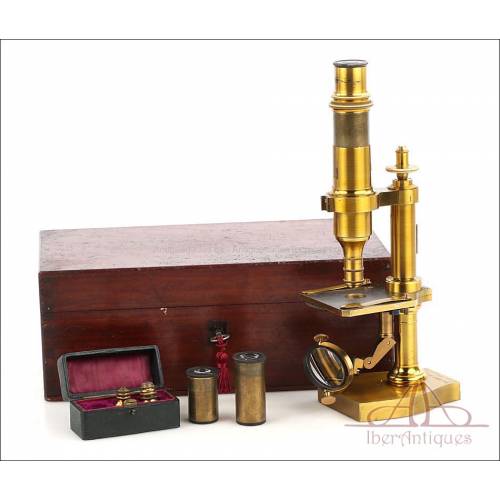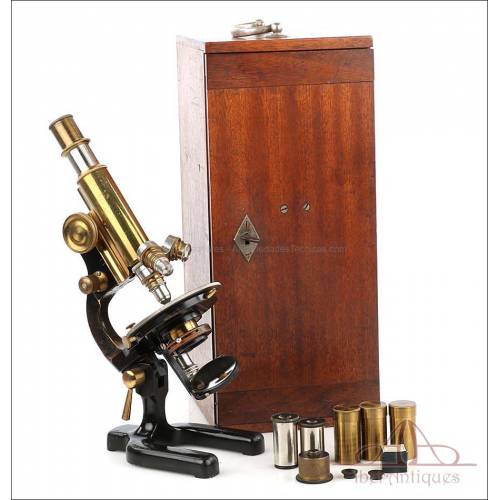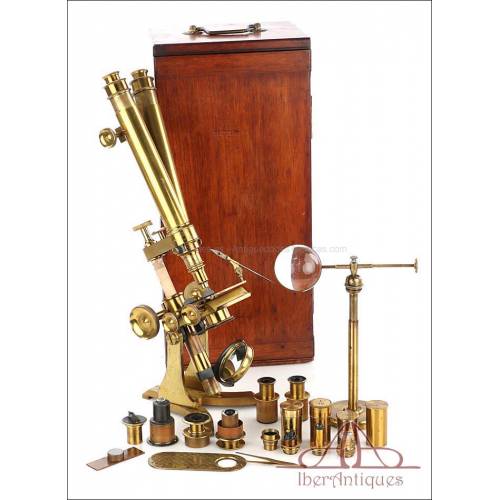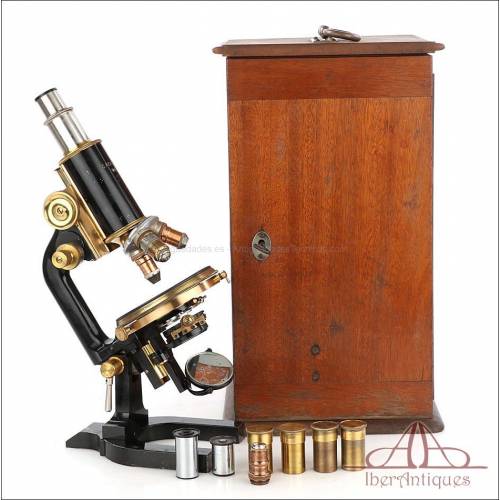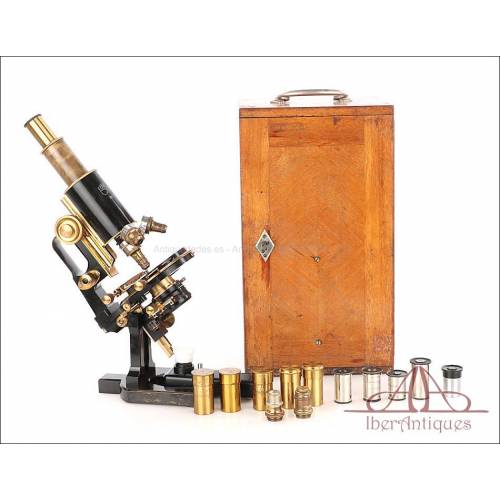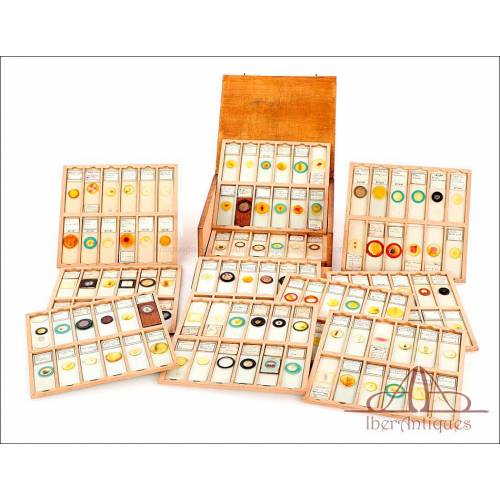Antique Microscopes
Collecting antique microscopes
The human being's thirst for wisdom knows no bounds. Just as he felt the need to observe distant bodies, his infinite curiosity led him to develop the microscope to perceive tiny objects. More than 400 years have passed since the invention of those ancient microscopes.
In the 13th century, the Italian Salvino D'Arm...
Collecting antique microscopes
The human being's thirst for wisdom knows no bounds. Just as he felt the need to observe distant bodies, his infinite curiosity led him to develop the microscope to perceive tiny objects. More than 400 years have passed since the invention of those ancient microscopes.
In the 13th century, the Italian Salvino D'Armato created eyeglasses, but the invention of the microscope is attributed to Zacharias Janssen, an eyeglass maker who, in 1590, created the first compound microscope. In 1665, the English scientist Robert Hooke published "Micrographia" where he described his experience with microscopy. He used the word cells for the first time. Anton van Leeuwenhoek was a Dutch merchant with skills in building microscopes. With them he observed red blood cells and spermatozoa for the first time in 1673. Findings such as this make him the "father of microbiology."
The invention spreads around the world
In the 18th and 19th centuries, several firms emerged in Europe and the United States to market this product. Some of them are still in force today. Among the most famous is the Ernst Leitz brand, which became one of the leading optical companies in the 19th century in Germany. It was later renamed Leica. Also in Germany, Carl Zeiss began production in 1847.
The microscopes he invented were very precise and of high quality. Today it is one of the leading companies in microscopy. Carl Friedrich Wilhelm Reichter founded his own company in Vienna in 1876; there he invented a modular and versatile microscope. The French optician Camille Sebastien Nachet designed models that placed great importance on aesthetics. This type of microscope was used by Pasteur and Cajal. Richard Beck's firm was first known as Smith&Beck until his brother James joined.
The English firm built lenses of excellent quality. William Watson founded the company in 1837 in London. His son Thomas extended the business by manufacturing photographic equipment. Thomas Ross was the son of Andrew Ross, a founding member of the Microscope Society in London in 1839. He was one of the top manufacturers in Victorian England. Henry Crouch was one of the top English microscope makers exporting to the United States after an impressive demonstration at a fair in 1876 in Philadelphia. The Bausch &Lomb company was founded in the United States by two German immigrants. They began by manufacturing spectacles. In 1874 they began building compound microscopes.
And these are just a few, though perhaps the most famous.
Most common types of antique microscopes
Over the years several types of microscopes were created according to the purpose behind them: mainly there are two main groups, simple microscopes and compound microscopes.
- - The simple microscopes: They use a single lens to magnify the observed samples and the magnification they provide is very limited.
- - The compound microscopes: They use a single lens to magnify the observed samples and the magnification they provide is very limited.
- - The composite microscopes. They have more complex optics because they are made up of multiple lenses. They are used to observe minute details that the human eye is unable to perceive. Among others we can find:
- - Monocular compound microscopes: they only have one tube for one eye. The great discoveries in microbiology were possible thanks to these types of microscopes.
- - Binocular microscopes: they contain two tubes for the eyes, one for each eye. The images they provide are sharper and allow observation for a prolonged time.
- - Binocular microscopes: contain two eye tubes, one for each eye.
- - Drum microscopes: they were designed by Benjamin Martin in the early 18th century. They are composed of a cylinder where the optics are located. They are made of brass although the first ones were made of wood and cardboard.
- - Drum microscopes.
- - Cary Gould type microscopes. Invented in 1820. Its portability made it very popular with naturalists, mineralogists and botanists.
- - Cary Gould type microscope.
- - Botanical microscopess. In the 18th and 19th centuries microscopes became the ideal tool for this guild. They were pocket-sized and had a small box to guard them.
- - Microscopes- Botanical microscopess.
- - Microscopes for dissection. They were patented in the 19th century and were used for what their name indicates.
- - Nuremberg type microscopes. Made of wood, the tube is inserted into a three-legged tripod on whose base is the mirror. They were manufactured in the 18th or early 19th century.
- - Antique petrographic microscopes. They identified crystalline and fibrous substances.
Some of these collector's gems have more than two hundred years behind them and a very special beauty. Antique microscopes are also witnesses to the passage of time and the advancement of mankind. Any collection of microscopes will shine on its own.
Antique Binocular Microscope Leitz Wetzlar from 1930. Germany. Antique Binocular Microscope...
Antique Leitz Wetzlar binocular microscope, rare 1930 model. Precise adjustments and clear vision, ideal for collectors and enthusiasts of scientific instruments. Antique Leitz Wetzlar binocular...
SoldAntique Nachet Brass Microscope Mod. 11. France, Circa 1890 Antique Nachet Brass Microscope...
Fine Nachet 11 microscope in very good condition. Original mahogany case. In great working order. Fine Nachet 11 microscope in very...
SoldAntique Seibert Wetzlar Monocular Microscope. Germany, Circa 1920 Antique Seibert Wetzlar...
Outstanding Seibert Wetzlar Monocular microscope in excellent working order. With wooden case, objectives and eyepieces. Outstanding Seibert Wetzlar Monocular...
SoldExtraordinary Antique Binocular Microscope. Super Complete. England, Circa 1880 Extraordinary Antique Binocular...
Exceptional binocular microscope with storing case and accessories. Very clear vision. Museums piece. Exceptional binocular microscope with...
SoldAntique Reichert Monocular Microscope. Vienna, circa 1920 Antique Reichert Monocular...
Big C. Reichert microscope from the early 20th century, with accessory set. Double shutter. In its original case. Big C. Reichert microscope from the...
SoldAntique Carl Zeiss Jena Jug-Handle Microscope. Germany, Circa 1920 Antique Carl Zeiss Jena...
Amazing jug-handle microscope by Carl Zeiss Jena. In excellent condition and with a complete accessory set. Original case and key. Amazing jug-handle microscope by Carl...
SoldGreat Collection of 144 Antique Microscope Slides. England, 19th Century Great Collection of 144 Antique...
Amazing collection of 144 microscope samples in good condition. In its original wooden case. Collectors piece. Amazing collection of 144 microscope...
Sold
New products
-

Antique ivory and silver plated stethoscope, late 19th century
Antique stethoscope from the late 19th century in silver-plated metal...
-

Vintage pendant with shell cameo of Jesús del Gran Poder, carved c. 1970
Vintage pendant with a shell-carved cameo of Jesus del Gran Poder, circa...
-

Antique Roman Style Gilded Silver Chalice with Paten. France, 1932
Antique Roman-style chalice in gilded silver with paten. France, 1932....
-

Beautiful Antique 18 K Gold Ring with 7 Natural Diamonds
Antique 18K gold ring with 7 natural diamonds. Delicate openwork design,...
-

Antique Silver Reliquary. José Vilaplana. Valencia, Spain. Circa 1920
Impressive repoussé silver reliquary by José Vilaplana, Valencia, c....
-

Vintage 18K Gold Ring with 7 Natural Diamonds
Vintage 18K gold ring with seven natural diamonds in floral setting....
-

Antique Silver Chalice. Enameled Crosses. Valencia, Spain, 1942
Spanish chalice from 1942 in solid silver, gifted by the Church of...
-

Antique Silver Chalice and Paten. Granada Spain, circa 1900
Spanish chalice in white silver with matching paten, handcrafted....
Specials
-

Rare Antique Pocket Watch with Calendar and Moon Phases. 67 mm. Switzerland, Circa 1890
Rare big-sized pocket watch with...

